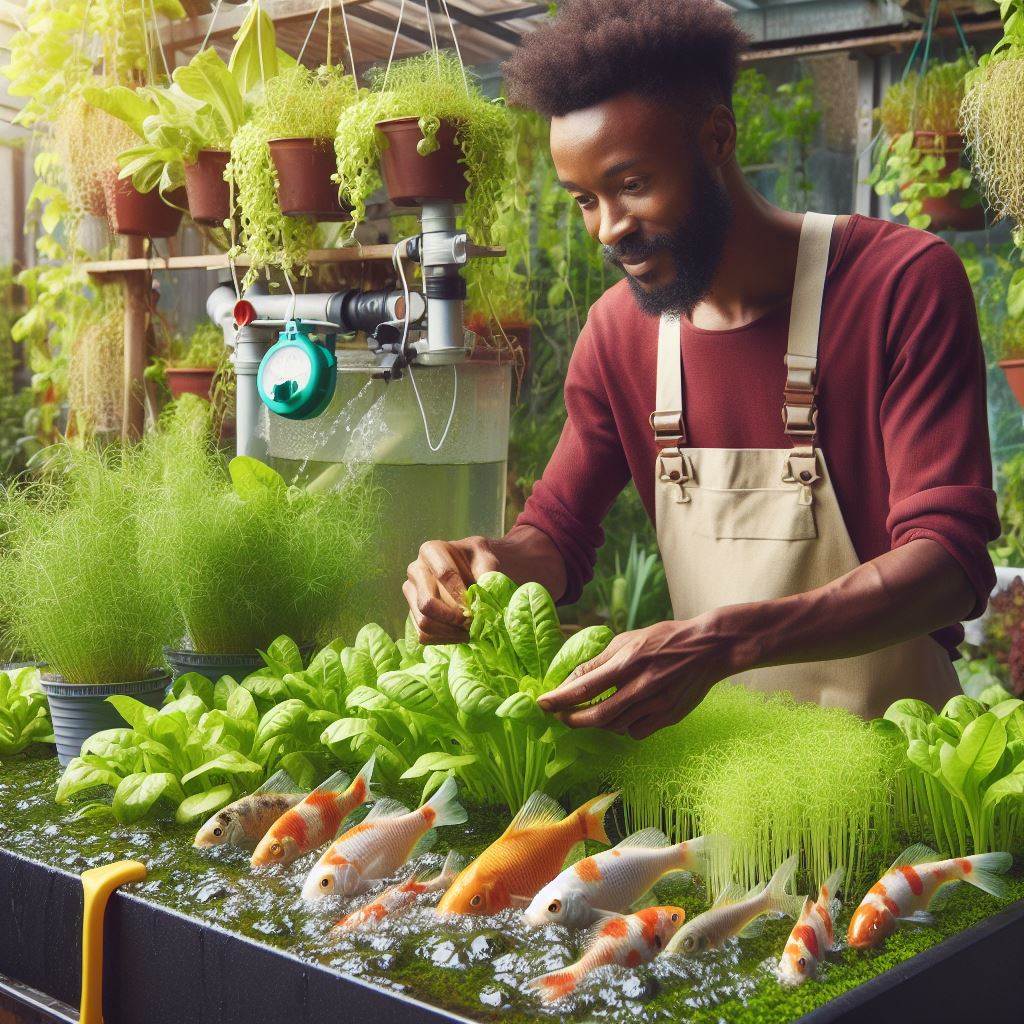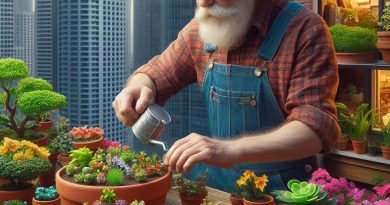Aquaponics 101: Fish & Plants in Harmony
Last Updated on February 25, 2024
Introduction
Aquaponics is a sustainable farming method that combines aquaculture and hydroponics.
It involves cultivating fish and plants together in a symbiotic environment.
Understanding aquaponics is vital for those interested in sustainable agriculture and food production.
By harnessing the natural relationship between fish and plants, aquaponics creates a closed-loop system that conserves water and eliminates the need for synthetic fertilizers.
This method also provides a continuous supply of nutrient-rich water that promotes plant growth.
Additionally, aquaponics reduces the risk of fish diseases as the plants act as a natural filter, cleaning the water for the fish.
The plants take up the fish waste as nutrients, effectively converting them into nourishment to fuel their growth.
This process creates a harmonious environment where both the fish and the plants benefit.
Aquaponics allows individuals to grow their own food in a sustainable and efficient manner, even in limited spaces.
It offers a unique opportunity to connect with nature and promote self-sufficiency.
By understanding the principles and techniques of aquaponics, individuals can become active participants in the movement towards a healthier and more environmentally friendly future.
In the following sections, we will explore the different components of aquaponics and learn how to implement this system successfully.
Together, we can unlock the potential of aquaponics and create a more sustainable world.
The Basics of Aquaponics
Brief history of aquaponics
Aquaponics, a combination of aquaculture (fish farming) and hydroponics (soilless plant cultivation), dates back to ancient civilizations.
How aquaponics works
- The role of fish: Fish produce waste, releasing ammonia into the water through their gills and excretion.
- The role of plants: Plants absorb the ammonia-rich water as nutrients for growth, cleaning the water for the fish.
- The symbiotic relationship between fish and plants: This natural process creates a harmonious cycle where fish provide nutrients to the plants, and the plants purify the water for the fish.
Benefits of aquaponics
Aquaponics offers several advantages over traditional farming methods:
- Sustainable and resource-efficient: Aquaponics uses 90% less water than traditional soil farming, making it a sustainable option.
- Eliminates the need for chemical fertilizers: The natural fish waste provides all the necessary nutrients for plant growth.
- Eliminates the need for pesticides: The controlled environment of aquaponics reduces the risk of pest infestation.
- Year-round cultivation: Aquaponics systems can function indoors, allowing year-round production regardless of climate.
- Higher crop yield: The symbiotic relationship between fish and plants promotes faster growth and higher yields.
- Diverse produce possibilities: With aquaponics, various plants and fish species can be cultivated together, providing a wide range of produce.
- Enhanced water conservation: The closed-loop system in aquaponics prevents water wastage and reduces overall environmental impact.
- Easy to maintain: Once the system is established, aquaponics requires minimal intervention, leading to easier maintenance.
- Enhanced food safety: The absence of toxic pesticides and fertilizers ensures clean and safe produce.
- Education and experimentation: Aquaponics offers a unique opportunity for learning and experimenting with sustainable farming techniques.
By understanding the basics of aquaponics, including its history, mechanisms, and benefits, individuals can appreciate this innovative approach to sustainable agriculture.
Read: DIY Hydroponics: Start Your Soil-less Garden!
Setting Up an Aquaponics System
Choosing the right location
- Look for a space with ample sunlight and a stable temperature to support plant growth.
- Ensure the location is easily accessible for maintenance and monitoring of the system.
Determining the size and scale of the system
- Consider the space available and your goals to determine the appropriate size of the aquaponics system.
- Start with a small-scale system if you’re a beginner and gradually expand as you gain experience.
Equipment and supplies needed
- Fish tank: Choose a tank that is suitable for the type and number of fish you plan to raise.
- Grow beds: Select beds that provide enough space for plant roots to grow and are compatible with the fish tank size.
- Plumbing system: Install pipes and fittings to create a continuous water flow between the fish tank and grow beds.
- Water filtration system: Incorporate filters to remove waste and maintain water quality for both fish and plants.
Choosing the right fish and plants for your system
- Fish species suitable for aquaponics include tilapia, catfish, and trout, depending on your climate and local regulations.
- Select plants that thrive in a water-based environment, such as lettuce, herbs, tomatoes, and strawberries.
Aquaponics provides a sustainable and efficient way to cultivate both fish and plants in a harmonious system.
To set up your own aquaponics system, it’s essential to consider several key factors.
Choosing the right location
First, choosing the right location is crucial.
Look for a space that receives ample sunlight and maintains a stable temperature to promote plant growth.
Additionally, ensure the location is easily accessible for monitoring and maintenance purposes.
Determining the size and scale of the system
Next, determine the size and scale of your aquaponics system.
Consider the space available and your goals for the system.
If you’re a beginner, starting with a small-scale system allows you to learn the ropes before expanding in the future.
Equipment and supplies needed
Equipping your system with the necessary supplies is also essential.
Begin with a suitable fish tank that can accommodate the type and number of fish you plan to raise.
Select grow beds that provide enough space for plant roots to thrive and match the size of your fish tank.
Install a plumbing system to establish a continuous water flow between the fish tank and grow beds.
In addition, incorporate a water filtration system to maintain water quality for both the fish and plants.
Choosing the right fish and plants for your system
When it comes to selecting fish and plants for your system, consider the species that are suitable for aquaponics.
Tilapia, catfish, and trout are popular choices, but make sure to check local regulations and climate suitability.
In terms of plants, choose varieties that thrive in a water-based environment, such as lettuce, herbs, tomatoes, and strawberries.
In general, setting up an aquaponics system requires careful consideration of various aspects.
From choosing the right location and determining the system’s size to acquiring the necessary equipment and selecting suitable fish and plants, each step plays a crucial role in establishing a successful aquaponics ecosystem.
With proper planning and attention to detail, you can create a thriving environment where fish and plants coexist in harmony.
Read: Eco-Friendly Pots: Sustainable Gardening
Maintaining an Aquaponics System
Effectively maintaining an aquaponics system requires careful attention to water quality, fish care, and plant management.
Water quality control
Water quality control is crucial to ensure the optimal growing conditions for both fish and plants.
By monitoring pH levels, you can adjust the acidity or alkalinity of the water to create an environment suitable for the organisms in the system.
Regular checks on ammonia and nitrate levels help prevent any harmful quantities that may negatively impact the health of the fish and plants.
Additionally, supplementing nutrients for the plants is necessary to maintain their growth and vitality.
Feeding and caring for the fish
Feeding and caring for the fish is essential for their overall well-being.
Regularly feed them a balanced diet appropriate for their species to ensure they receive the necessary nutrients.
Carefully monitor their behavior and appearance to identify any signs of illness or stress.
Proper maintenance of their living conditions, such as temperature and oxygen levels, is also crucial for their health and growth.
Managing plant growth
Managing plant growth is crucial to optimize the efficiency and productivity of the aquaponics system.
Pruning and harvesting techniques should be employed to maintain plant shape, control growth, and promote better nutrient distribution.
Harvesting mature plants allows for continuous growth and prevents overcrowding.
Moreover, preventing pests and diseases is essential to protect the plants from potential harm.
Introducing beneficial insects or using organic pest control methods can help mitigate the risk of infestation and diseases.
Essentially, maintaining an aquaponics system requires continuous monitoring of water quality, proper care for the fish, and effective plant management.
By doing so, you can ensure the system’s sustainability, productivity, and the overall harmony between fish and plants.
Read: Pocket-Sized Herb Gardens: Urban Farming Tips

Troubleshooting Common Issues in Aquaponics
Algae overgrowth in the system
Algae overgrowth can occur in an aquaponics system due to excessive nutrients or sunlight exposure.
- Reduce nutrient levels by adjusting fish feeding and monitoring water quality regularly.
- Provide shade to the system or use a cover to limit sunlight penetration.
- Introduce algae-eating fish like tilapia or herbivorous snails to control algae growth.
- Implement a regular cleaning schedule to remove excess algae manually.
Fish health problems
Maintaining fish health is essential for the success of an aquaponics system.
- Monitor water quality parameters such as temperature, pH, ammonia, and nitrate levels.
- Ensure sufficient oxygen levels by adding aeration devices or increasing water surface agitation.
- Regularly inspect fish for signs of disease, such as abnormal behavior, lesions, or changes in appetite.
- Quarantine new fish before introducing them to the main system to prevent the spread of potential diseases.
- Consult a veterinarian or aquaculture expert if fish health problems persist.
Poor plant growth or deficiency symptoms
If plants in your aquaponics system are not growing properly or showing nutrient deficiency symptoms, several factors could be responsible.
- Check water pH and adjust if necessary, as extreme levels can affect nutrient availability.
- Test water for nutrient levels and make adjustments accordingly.
- Ensure adequate lighting for plant growth, providing a minimum of 12-16 hours of light per day.
- Verify that the plant’s root system is healthy and properly established in the grow media.
- Consider adding additional beneficial bacteria or organic supplements to enhance nutrient uptake.
Dealing with system imbalances
An aquaponics system is a delicate balance of fish, plants, and bacteria, and any disturbance can lead to imbalances.
- Regularly test water parameters and adjust nutrient levels accordingly.
- Maintain a proper fish-to-plant ratio to ensure adequate nutrient distribution.
- Avoid overfeeding fish, as excess uneaten food can lead to ammonia spikes and system imbalances.
- Monitor system temperatures to prevent extreme fluctuations that may affect fish or plant health.
- Implement a backup power source or heating system in case of power outages or colder climate conditions.
In essence, troubleshooting common issues in aquaponics requires regular monitoring of water quality, nutrient levels, fish health, and plant growth.
By maintaining a balanced system and making necessary adjustments, aquaponic enthusiasts can prevent and resolve potential problems, ensuring the overall success of their sustainable farming endeavors.
Read: Kitchen Window Herbs: Grow Your Own Flavor
Success Stories and Examples
Aquaponics has transformed the lives of many individuals, from backyard enthusiasts to commercial farmers.
In this section, we will present real-life success stories and examples of aquaponics systems at different scales, showcasing the harmony between fish and plants.
Presenting real-life aquaponics success stories
- John Smith, a backyard aquaponics enthusiast, shares his inspiring journey of turning his small backyard into a thriving source of fresh vegetables and fish. With a passion for sustainable living, John utilized the waste produced by his fish to nourish his plants, creating a closed-loop system that required minimal input. His efforts resulted in an abundant vegetable garden and a healthy fish population.
- Sarah Thompson, a small-scale farmer, struggled with water scarcity in her region. Determined to find a sustainable solution, she implemented an aquaponics system on her farm. By integrating fish and plants, Sarah was able to maximize the use of water while achieving higher crop yields. The symbiotic relationship between the fish and plants created a self-sustaining ecosystem that greatly reduced her water consumption and increased her farm’s productivity.
- David Rodriguez, a commercial aquaponics farmer, ventured into the world of aquaponics with the goal of supplying local restaurants with fresh and organic produce. His large-scale aquaponics farm has become a success story in the industry, providing a consistent supply of high-quality vegetables and fish. David’s commitment to sustainable farming practices and the efficient use of resources has made his business a model for others to follow.
Showcasing different scale systems – backyard to commercial
- Backyard Aquaponics: For those interested in starting their own aquaponics system at home, the journey begins in the backyard. With step-by-step instructions and helpful tips, we will guide you through the process of setting up a small-scale system. You will learn about the selection of fish and plants, system maintenance, and the joys of growing your own food.
- Community Aquaponics: Discover the power of collaboration and community involvement in aquaponics. We will take you on a virtual tour of a community garden project where neighbors come together to create a sustainable food production system. Witness the sense of camaraderie as individuals share their knowledge, resources, and fresh produce, fostering a stronger and more resilient community.
- Commercial Aquaponics: Explore the fascinating world of large-scale aquaponics farms supplying supermarkets with organic produce. Witness the innovation and advanced techniques used in these commercial setups to maximize productivity and efficiency while ensuring the highest quality of food. These success stories highlight the potential of aquaponics to revolutionize modern agriculture and contribute to a more sustainable future.
Aquaponics has proven to be a transformative practice for individuals and communities alike.
These success stories and examples demonstrate the immense potential of aquaponics in achieving food security, water conservation, and sustainable agriculture.
Whether you are a backyard enthusiast or a commercial farmer, aquaponics offers a harmonious way to grow both fish and plants while promoting ecological balance.
Conclusion
Recap of the key points discussed:
Throughout this blog post, we delved into the fascinating world of aquaponics, a sustainable farming method that combines fish and plants in harmony.
We explored the basic concept of aquaponics, understanding how it works and the benefits it offers.
We first learned about the symbiotic relationship between fish and plants in an aquaponics system.
The fish produce waste, which is then converted into nitrates by beneficial bacteria.
These nitrates are then used as nutrients by the plants, removing harmful toxins from the water in the process.
Next, we discussed the advantages of aquaponics.
This method allows for the production of both fish and plants simultaneously, maximizing the use of limited space.
It requires less water compared to traditional farming methods, reducing the strain on scarce water resources.
Additionally, aquaponics eliminates the need for chemical fertilizers and pesticides, making it an environmentally friendly and sustainable approach to food production.
Encouragement to explore aquaponics as a sustainable farming method
In conclusion, aquaponics presents a promising solution for sustainable agriculture.
By combining fish and plants in a mutually beneficial system, we can produce fresh and nutritious food while minimizing environmental impact.
If you are passionate about sustainable farming and interested in exploring new methods, aquaponics is definitely worth considering.
Whether you are an experienced farmer or just starting out, aquaponics provides an opportunity to grow your own food and make a positive impact on the planet.
So, dive into the world of aquaponics and discover the endless possibilities it offers.
Explore different setups, experiment with varieties of fish and plants, and embrace this innovative and ecologically responsible farming method.
Together, we can work towards a healthier and more sustainable future for our planet.
Start your aquaponics journey today!


